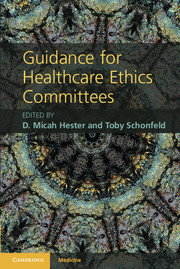Book contents
- Frontmatter
- Contents
- Contributors
- Preface
- Section 1 The Context of Healthcare Ethics Committee Work
- Section 2 Consultation
- 5 Mission, vision, goals: defining the parameters of ethics consultation
- 6 Ethics consultation process
- 7 Informed consent, shared decision-making, and the ethics committee
- 8 Decision-making capacity
- 9 Family dynamics and surrogate decision-making
- 10 Confidentiality
- 11 Advance care planning and end-of-life decision-making
- 12 Medical futility
- 13 Ethical issues in reproduction
- 14 Ethical issues in neonatology
- 15 Ethical issues in pediatrics
- Section 3 Policy Development and Organizational Issues
- Section 4 Educating Others
- Index
- References
14 - Ethical issues in neonatology
Published online by Cambridge University Press: 05 August 2012
- Frontmatter
- Contents
- Contributors
- Preface
- Section 1 The Context of Healthcare Ethics Committee Work
- Section 2 Consultation
- 5 Mission, vision, goals: defining the parameters of ethics consultation
- 6 Ethics consultation process
- 7 Informed consent, shared decision-making, and the ethics committee
- 8 Decision-making capacity
- 9 Family dynamics and surrogate decision-making
- 10 Confidentiality
- 11 Advance care planning and end-of-life decision-making
- 12 Medical futility
- 13 Ethical issues in reproduction
- 14 Ethical issues in neonatology
- 15 Ethical issues in pediatrics
- Section 3 Policy Development and Organizational Issues
- Section 4 Educating Others
- Index
- References
Summary
Objectives
Understand what makes the neonatal intensive care unit (NICU) ethically unique.
Recognize ways in which improved prenatal diagnosis may change neonatal care and may create additional ethical challenges.
Describe diferent clinical populations in the NICU and the implication for ethical decision-making.
Case 1
A healthy 25-year-old married woman who had good prenatal care goes into labor at 25 weeks and 3 days of gestation. The dates were established by two ultrasounds done at 8 and 16 weeks of gestation. She and her husband have a healthy 3-year-old athome. Both parents are informed that the doctors recommend antenatal steroids and a C-section. They are also informed that, once the baby is born, he or she will likely require intubation and mechanical ventilation. After thoughtful discussion with her husband, the woman opts not to receive steroids. They request that only comfort care be provided to their newborn.
A baby girl is born by vaginal delivery. In the delivery room, the baby has a heart rate of 130 and a weak cry. The baby’s birthweight is 750 grams. Should the doctors follow the parents’ wishes for palliative care, or should they intubate the baby and provide mechanical ventilation and other NICU care?
- Type
- Chapter
- Information
- Guidance for Healthcare Ethics Committees , pp. 106 - 113Publisher: Cambridge University PressPrint publication year: 2012



